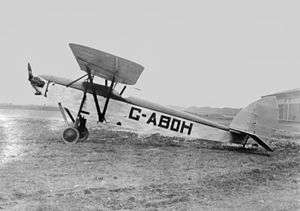RAE Scarab
| Scarab | |
|---|---|
 | |
| Role | Single-seat sports aircraft |
| National origin | United Kingdom |
| Manufacturer | Aero Club of the Royal Aircraft Establishment |
| Designer | P G N Peters and C R Brewer |
| First flight | February 1932 |
| Number built | 1 |
| Developed from | de Havilland Humming Bird |
The RAE Scarab was a light single-engined single-seat parasol winged modification of the de Havilland Humming Bird, flying in the United Kingdom in 1932. Only one was built.
Development
The Aero Club of the Royal Aircraft Establishment built two light aircraft in 1923, the Zephyr and the Hurricane, then no more until 1931.[1] This, their final effort was the RAE Scarab or PB Scarab as it is sometimes known,[2] after its designers P G N Peters and C R Brewer.[3] Even so, it was not all their own work for the wing and empennage were from a low-winged DH.53, itself a 1923 aircraft. What they did was to reposition the wing on a new fuselage to make a new, parasol winged monoplane, a change that required the creation of a centre section and the struts to support it.[2][3][4]
With its new fuselage,[3][5][6] the Scarab was longer than the DH.53, at 21 ft 0 in (6.40 m)[4] compared with 19 ft 8 in (5.99 m).[7] Most of the extra length was in the nose, for the DH.53 was a very snub-nosed machine compared with the Scarab. Both aircraft had flat sided fuselages built up from four longerons in the usual manner of the time, with rounded decking. The DH.53 pilot had sat over mid-chord, but the combination of 5o of sweepback[3] and the change of centre of gravity due to the longer nose in the Scarab meant he could sit at the trailing edge of the new, narrow chord[3] centre section. Given the small gap between the top of the fuselage and the underside of the parasol wing, a mid chord cockpit would have been inaccessible and have restricted the pilot's view severely. A pair of lift stuts extended in a V from the lower fuselage longerons on each side to the two wing spars[3] at the point where these were thickened[8] for the compression struts of the DH.53. As on the DH.53, the wings had constant chord with slightly rounded tips, carrying long differential ailerons. In contrast to those of the DH.53, the wings of the Scarab folded for transport.[3] The Scarab's undercarriage was also new, a split axle unit with the main legs going to the upper longerons and bracing to the lower ones. The undercarriage track was 5 ft (1.52 m).[2] Like some DH.53s,[7] the Scarab was powered by a 32 hp (24 kW) Bristol Cherub III flat twin.[2]
The sole Scarab was registered[9] as G-ABOH . Its first flight was in February 1932 with H.H. Leech at the controls.[4] Though underpowered and slow, it seems to have flown nicely and had a surprising rate of climb.[3] It flew from Farnborough until 1938, when it was stored and then scrapped in 1945.[4]
Specifications
Data from Flight 19 February 1932 p.149[2]
General characteristics
- Crew: 1
- Length: 21 ft 0 in (6.40 m)
- Wingspan: 30 ft 0 in (9.14 m)
- Height: 6 ft 9 in (2.06 m) spread, 127 sq ft (11.8 m2) swept
- Empty weight: 460 lb (209 kg) [3]
- Gross weight: 650 lb (295 kg)
- Powerplant: 1 × Bristol Cherub III flat twin, 32 hp (24 kW) at 3,200 rpm
Performance
- Maximum speed: 78 mph (126 km/h; 68 kn)
- Cruise speed: 68 mph (59 kn; 109 km/h) [3]
- Stall speed: 32 mph (28 kn; 51 km/h)
- Range: 200 mi (174 nmi; 322 km) [3]
- Rate of climb: 600 ft/min (3.0 m/s)
References
Citations
- ↑ In 1926 they designed and started to build the RAE Sirocco for the Lympne trials, but it was never completed. See Jackson (1960) p.517
- 1 2 3 4 5 Flight 19 February 1932 p.149
- 1 2 3 4 5 6 7 8 9 10 11 Ord-Hume 2000, pp. 456
- 1 2 3 4 Jackson 1960, pp. 410
- ↑ Jackson 1974, pp. 286
- ↑ In the 1st edition (1960) of British Civil Aircraft, Jackson says that the DH.52 fuselage was retained, but the 1974 edition makes it clear it was new, in agreement with Ord-Hume
- 1 2 Jackson 1978, pp. 208–9
- ↑ Jackson 1978, pp. 203
- ↑ Registration of G-ABOH
Cited sources
| Wikimedia Commons has media related to RAE Scarab. |
- Jackson, A.J. (1960). British Civil Aircraft 1919-59. 2. London: Putnam Publishing.
- Jackson, A.J. (1974). British Civil Aircraft since 1919 Volume 3. London: Putnam. ISBN 0-370-10014-X.
- Jackson, A.J. (1978). de Havilland Aircraft since 1909. London: Putnam Publishing. ISBN 0-370-30022-X.
- Ord-Hume, Arthur W.J.G. (2000). British Light Aeroplanes. Peterborough: GMS Enterprises. ISBN 978-1-870384-76-6.